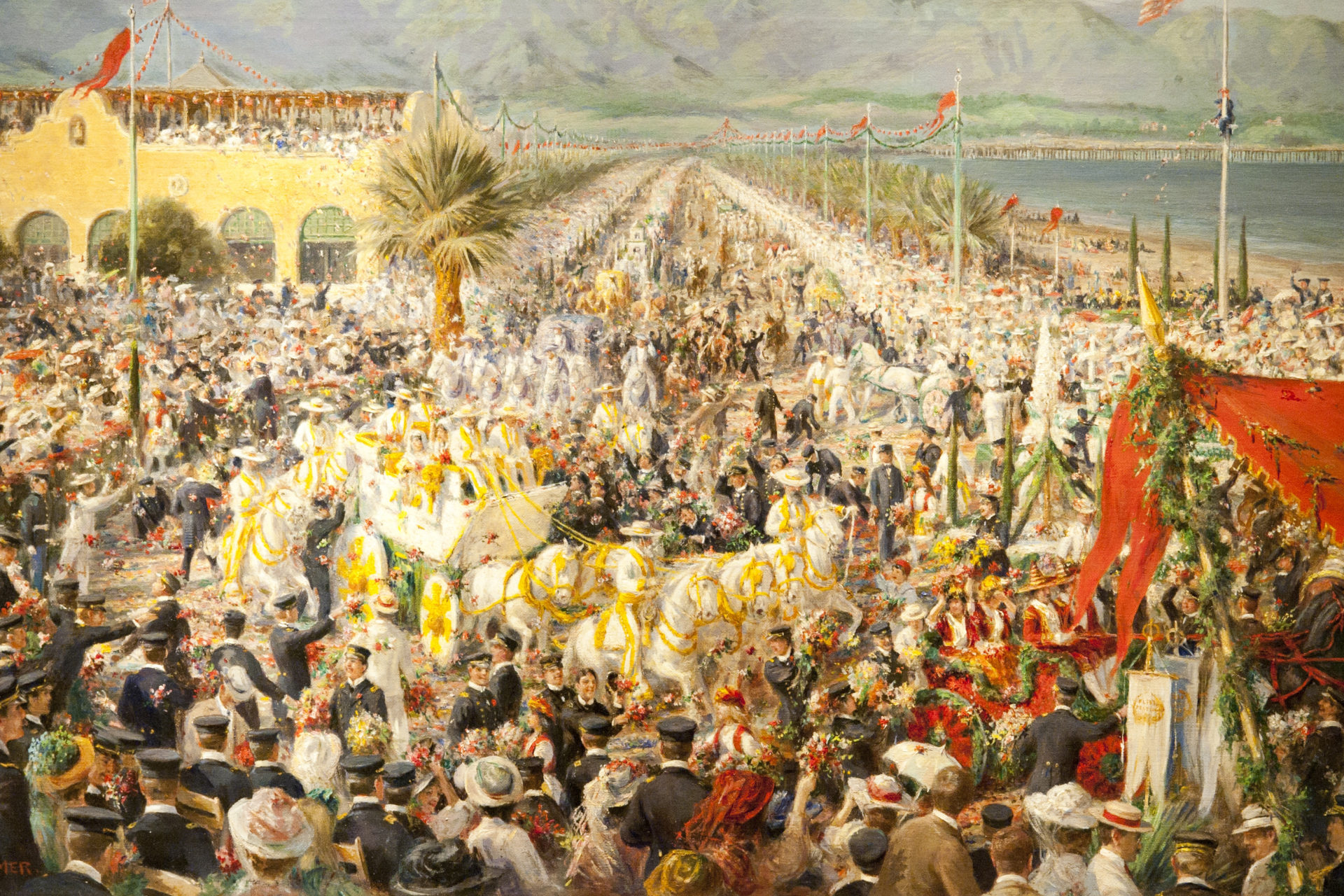On April 25, 1908, Santa Barbara welcomed the Great White Fleet and it’s estimated fifteen thousand sailors with a tremendous Battle of the Flowers celebration parade on the Santa Barbara waterfront. The sixteen white battleships had been ordered by President Theodore Roosevelt in 1907 to cruise around the world on a peacekeeping mission. Upon its arrival, the fleet demonstrated its navigational skill by steaming into Santa Barbara in the tightest formation that battleships had ever achieved up to that time. The Fleet Festival continued for several days.
Battle of the Flowers, Fleet Festival, 1908
Alexander F. Harmer (American, 1856-1925)
Oil on canvas
20 x 36 inches
Gift of Glenn and Louise Idleman
xx.54.5
The palatial Punta del Castillo (Castle Point), was considered one of the most elaborate residences built in Santa Barbara during the late nineteenth century. The Italianate-styled mansion was designed by the city’s premier architect, Peter J. Barber, and completed in 1886. Here the Dibblees entertained in grand style.
Dibblee Family Tea Service, Chinoisene-style, c. 1870
Sterling silver; W. Adams, New York, maker
Carmen Dibblee Underhill Bequest
x.66.12.17
Stemware, c. 1880
Lead crystal; Baccarat, maker
Gift of Frederica Dibblee Poett
1991.140.3
Wedding Necklace, 1902
Designed for Mercedes Dibblee Poett, from her mother, Francisca.
Gold, pearls, diamonds
Shreve & Co., San Francisco, maker
Lent courtesy Delfina Russell Mott
Mercedes Dibblee Poett, 1902
Porcelain wedding portrait
Frederica Dibblee Poett Bequest
1999.98.7
Francisca’s Gold Thimble and Wedding Band
Frederica Dibblee Poett Bequest
1999.98.13 &16
In 1868, Thomas Bloodgood Dibblee married Francisca de la Guerra, whose marriage signified the blending of Spanish and Anglo-American cultures in Santa Barbara. Francisca was born in Casa de la Guerra in 1848, and was a granddaughter of Don José de la Guerra.
Francisca de la Guerra Dibblee, 1872
Guiseppe Fagnani (Italian, 1819-1873)
Oil on canvas
27 ¼ x 22 ¼ inches
Frederica Dibblee Poett Bequest
1999.98.30
During her lifetime, Francisca Dibblee perpetuated the traditions of old California in song and dance that had passed down through the de la Guerra family. She was known to regale her guests with her repertoire of nearly 150 folk songs performed on her beloved guitar.
Velvet Tea Gown, c. 1880
Francisca de la Guerra Dibblee
Gift of The Dibblee Family
8.69.95.1
French Fan, c. 1840
Ivory guards and sticks
Gift of Rose Cronise Estate
50.60.13.7
Pocket Watch, c. 1870
Thomas Bloodgood Dibblee
Gift of Mercedes Dibblee Poett and Delfina Dibblee
3.67.40.3
Thomas and Francisca de la Guerra Dibblee purchased this guitar in New York City while on their honeymoon in 1868-69. The guitar is considered the earliest known example of Martin’s work.
Guitar, circa 1868
C.F. Martin & Co., maker
Spruce, mahogany, rosewood, and ivory
Gift of Virginia Dibblee
Restoration made possible through the generosity of Chris Jensen, Jensen Guitar & Music Company
1.84.4.4
Santa Barbara’s second grand hotel, the Potter, opened in 1903. East Coast families, including Rockefeller, Carnegie and Vanderbilt, traveled in private railroad cars to “winter” at the hotel. Situated on thirty-six oceanfront acres, guests enjoyed impeccable grounds with its 30,000 rose bushes, deer park and zoo. Built by Milo M. Potter at a cost of $1.5 million, the hotel accommodated six hundred guests. Potter sold in 1918 and the hotel burned to the ground in 1921.
Diehl’s Grocery Teapot, silverplate, c. 1903
Gift of Litti Paulding
1.64.4.1
Demitasse Cup and Saucer, porcelain, c. 1903
Gift of Carolyn Stanwood
1.62.10.2
Luncheon and Dinner Forks, silverplate, c. 1903
Gift of Ken and Mary Lou Riley
1999.94.4 & 5
Hotel Menu, 1910
Gift of Bruce Gifford
1996.94.4. & 5
Postcards and Hotel Brochure, c. 1912
Gift of Marjorie G. Hanlon
5.70.57.6 & 7

